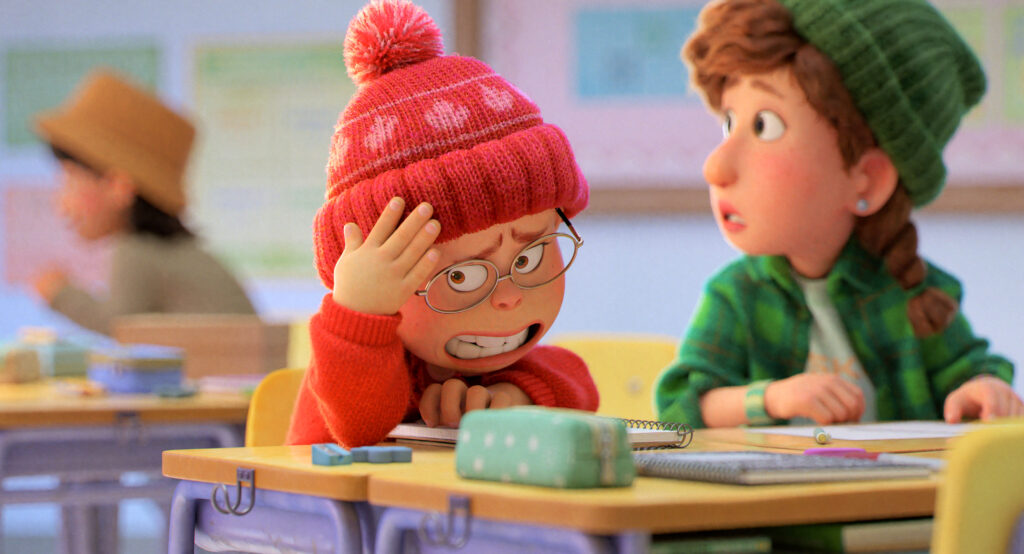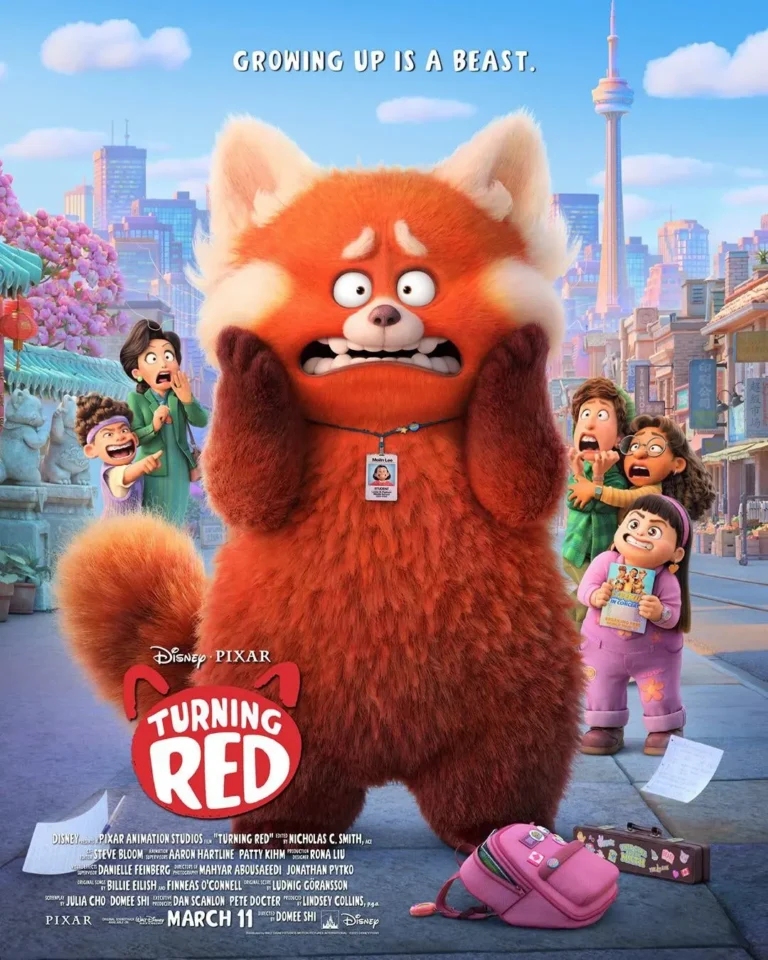Turning Red – Snapshot
Turning Red is, at times, a cute and simple story about a 13-year old girl, Mei, living with her Chinese mother and father in Toronto, Canada in 2002. Mei discovers that growing up is sometimes full of unexpected difficulties. The film has terrific colors and computer animation, but I can’t help but wonder who is supposed to watch it? (2*)
Where to Watch:
Stream: Disney+
Rent/Buy: Prime/Apple ($10)
This movie is hard to find. I couldn’t find anyplace to rent it and so, if you do not subscribe to Disney+, your only option is to buy it! A steep price for a movie that isn’t going to satisfy a lot of people!
Turning Red – The Oscar Buzz
Oscar Nominations:
Animated Feature Film
Turning Red received a single nomination for Animated Feature Film, putting it in our “special interest” list. (Guillermo del Toro’s Pinocchio won the Oscar!). The score, which is very good, is by Ludwig Goransson who won the Musical Score Oscar for Black Panther (18) and received an Original Song nomination for “Lift Me Up” in Black Panther: Wakanda Forever (22).
Turning Red – The Movie’s Family Tree
The Following Movies Share Talent with This One (and if you like these films, you might like this one):
Bao (18) Animated Short Oscar Winner: Director/Writer(Shi)/Production Design (Liu)
Incredibles 2 (19): Director(Shi-as Story Artist)/Cinematography(Abousaeedi)/Production Design (Liu)
Coco (17)/Brave (12): Cinematography (Pytko)/Editor (Bloom/Smith)
Turning Red is a production of Disney’s Pixar Animation Studios and so it is reasonable to expect it shares talent with the studio’s earlier movies. It was directed and written by Domee Shi who was also responsible for the Oscar winning animated short, Bao. The other three Pixar movies listed above also shared specific talent from the studio. Music fans might be interested to know that Billie Eilish co-wrote three of the songs in Turning Red!
Turning Red – What Others Think
Turning Red is one of those films the critics loved and the viewing public really did not. Audience ratings place it at the bottom of this year’s animated features and near the bottom of all 39 of this year’s movies. It should be noted, however, that because it is only available to stream on Disney and can’t be rented anywhere else, the rankings are only based on about 144,000 reviews, a relatively small number.
Critics, never wanting to reflect popular taste, ended up placing this film near the top of the animated slate and in the top third of all of this year’s Oscar-nominated films. However, I only found one big-name review, from Maya Phillips (New York Times). For her, Turning Red “(was a) sometimes heartwarming but wayward coming-of-age movie, which toes the line between truthfully representing a Chinese family, flaws and all, and indulging stereotypes.” She found that the portrayal of Mei’s grandmother and aunts “…fall into a formula of cold, emotionless Asian women.” But despite it fumbling the storytelling, at “least it has fun when it lets fur fly.”
Turning Red – Special Mention
The Red Panda – plays a special role in Turning Red and it is important to ask what is this about – why a Red Panda? Unfortunately I don’t have good answers to that question. The Red Panda is real enough – it is an animal that lives in the Himalayas and southwestern China. Despite the name, it isn’t related to the Giant Panda and isn’t even a bear but rather is an evolutionary cousin to raccoons, weasels and skunks. Because it shares a similar bamboo forest habitat and food source with Giant Pandas, it has “convergently evolved” a false thumb to aid in grasping bamboo shoots, similar to the panda bears and, perhaps adding to their perception as related. They are also quite a bit smaller – ranging in size from 7 – 33 pounds, about as big as one of my Welsh Corgis!
In central Bhutan, Red Pandas are considered to be reincarnations of Buddhist monks but I couldn’t find any special association in Chinese culture. Hats made of red panda tails are considered good luck charms at Chinese weddings. One source I found (cutpopup.com) suggested the animal is a Chinese symbol for gentleness, compromise, patience, balance, independence, and nonchalance. (Frankly, though, except for independence, I don’t find how that relates to its role in Turning Red at all!)
Turning Red – Michael’s Moments
Turning Red reportedly cost $175 million to make, which is almost more than all four other animated features combined. Of course the film shows the remarkably seamless animation qualities and bright vivid colors that we’ve come to expect from a Pixar film. And, I’m guessing, that Sandra Oh extracted a pretty good salary playing Mei’s mother. But the other major characters are all young voice actors without long movie filmographies. And three songs from Billie Eilish and a score from Oscar-winner Goransson probably cost a little bit. But I can’t see how all of this adds up to such a staggering amount. (For another comparison, note that Everything Everywhere All At Once had an estimated budget of $25 million, and it won seven Oscars, including Best Picture!
So what were the producers thinking as to how to recoup that kind of outlay? Following in the footsteps of movies like Inside Out and Soul, two Animated Feature Oscar winners, the Disney/Pixar animation team has been trying to make movies that explore subjects that intrigue both kids and adults, such as emotions, and death – deep and intriguing subjects with a wide range of audiences. They may have expected Turning Red – which explores some of the effects of puberty on girls – to gather the same kind of attention. But after a limited theater run, which only did $20 million at the box office, they then limited its streaming run to Disney+. Of course, we don’t have any idea how to measure its financial success on that channel because Disney doesn’t release streaming counts nor give estimates of revenue attributed to a particular movie. But it isn’t likely that they’ve even broken even, especially when the only option for non-Disney subscribers is to purchase the movie for a rather steep $10. It seems like Disney is doing everything in its power to keep the film from being successful and that strategy appears to be working since fewer than 150,000 viewers have rated the film on IMDB, and, as mentioned above, the ratings aren’t very good.
I don’t think I can explain Disney’s business strategy on Turning Red, which seems to me to be fairly weak. But I can point out a few reasons why the film doesn’t rate well. First is the focus on the Chinese family which, unfortunately ends up mostly reinforcing standard cultural tropes. The father plays a very unexceptional role except in one place where he tries to comfort Mei, but his parental actions are limited and not very convincing. Ming, Mei’s mother, is much more involved but in a hyper-vigilant way, and a helicopter parent isn’t very attractive to teenagers now or ever. And Ming’s grandmother and aunts seem to be classic examples of the stoic Asian maternal family – don’t look for any sympathy, only attempts at control.
In the end, Mei determines her own future and that is clearly the point of the movie. But in today’s world I don’t think that is a major breakthrough – teenagers switch primary allegiance from family to friends as an expected matter of course. So what really was the theme of this movie and who was the expected audience?
On the one hand, its focus on an Asian family and culture in Toronto, Canada might position the movie as a kind of cultural breakthrough for Asians in the animated universe. But if the film doesn’t convey anything new and only communicates old style Asian stereotypes, then why would there be a favorable viewing experience for those viewers?
Maybe the intended audience is teenagers, suffering their own angst and growing up pains. Well maybe, but then what does the red panda have to do with anything? Sure teenage hormones make kids do some pretty strange things, but plenty of other films have communicated this kind of message with far more success than Turning Red. And I suspect the male half of that population might have more than a little discomfort linking the Red Panda to menstruation, almost implying that boys are exempt from the problems of adolescence.
In my review of this year’s animated feature Oscar winner, Guillermo del Toro’s Pinocchio, I lauded the animation and some of the characters. But I couldn’t find the audience that del Toro was trying to reach with his film, ultimately concluding that, as the title of the film suggests, he did it primarily for himself. Like that film, Turning Red suffers from the problem of not having a clear audience for its message. It is almost like writer/director, Domee Shi (born in China), powered by her success with Bao, developed another feature-length film expressing her Chinese heritage and the problems of being a teenage girl. Disney ran with it, hoping, I guess for another success. But despite generally good reviews, Turning Red, is a cute diversion for a limited audience but doesn’t have lasting value. (2*)


